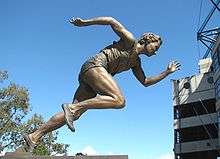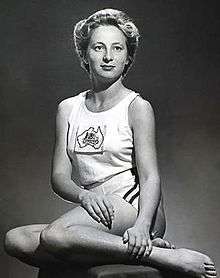Shirley Strickland
 Strickland at the 1950 Empire Games in Auckland | ||||||||||||||||||||||||||||||||||||||||||||||
| Personal information | ||||||||||||||||||||||||||||||||||||||||||||||
|---|---|---|---|---|---|---|---|---|---|---|---|---|---|---|---|---|---|---|---|---|---|---|---|---|---|---|---|---|---|---|---|---|---|---|---|---|---|---|---|---|---|---|---|---|---|---|
| Full name | Shirley Barbara Strickland de la Hunty[1] | |||||||||||||||||||||||||||||||||||||||||||||
| Nationality | Australian | |||||||||||||||||||||||||||||||||||||||||||||
| Born |
18 July 1925[2] Guildford, Western Australia | |||||||||||||||||||||||||||||||||||||||||||||
| Died |
17 February 2004 (aged 78) Perth, Western Australia[2] | |||||||||||||||||||||||||||||||||||||||||||||
| Alma mater | University of Western Australia | |||||||||||||||||||||||||||||||||||||||||||||
| Height | 1.72 m (5 ft 7 1⁄2 in)[1] | |||||||||||||||||||||||||||||||||||||||||||||
| Weight | 50.8 kg (112 lb)[1] | |||||||||||||||||||||||||||||||||||||||||||||
| Sport | ||||||||||||||||||||||||||||||||||||||||||||||
| Sport | Athletics | |||||||||||||||||||||||||||||||||||||||||||||
| Event(s) | 100–400 m, 80 m hurdles | |||||||||||||||||||||||||||||||||||||||||||||
| Club | University, Applecross, Melville | |||||||||||||||||||||||||||||||||||||||||||||
| Achievements and titles | ||||||||||||||||||||||||||||||||||||||||||||||
| Personal best(s) |
100 m – 11.3 (1955) 200 m – 24.1 (1955) 400 m – 56.6 (1956) 80 mH – 10.89 (1956)[1][3] | |||||||||||||||||||||||||||||||||||||||||||||
Medal record
| ||||||||||||||||||||||||||||||||||||||||||||||
Shirley Barbara de la Hunty AO, MBE (née Strickland; 18 July 1925 – 11 February 2004), known as Shirley Strickland during her early career, was an Australian athlete. She won more Olympic medals than any other Australian in running sports.
Family
Strickland was the only daughter, the second of five children. She grew up on the family farm east of the wheatbelt town of Pithara, Western Australia.
Her father, Dave Strickland, while working at Menzies in the goldfields of Western Australia, was also an athlete.[4][5] He was unable to compete in the 1900 Summer Olympics because he lacked the money for a trip to Paris.[6] Instead, in 1900, he directed his efforts to the Stawell Gift 130-yard (120-m) foot-race, winning in 12 seconds off a handicap of 10 yards.[7] His performance was considered to be as good as those of Stan Rowley, who won the Australian amateur sprint titles that season. (Rowley went on to win three bronze medals in the sprints at the 1900 Paris Olympics). Dave Strickland subsequently went on to play one senior game of Australian Rules football with Melbourne-based VFL team St Kilda in 1900[8] and six with WAFL club West Perth spread across the 1901 and 1909 seasons.
Her mother, Violet Edith Merry, was American-born with a British mining engineer father and a Norwegian mother.[5]
Education
Shirley Strickland's early education was by correspondence. From 1934 to 1937 she attended the newly established local East Pithara School, winning a scholarship to attend Northam High School,[9] where, in 1939, she won 47 out of 49 events as a schoolgirl athlete.[10] After high school she entered the University of Western Australia from where in 1946 she graduated with a Bachelor of Science (Honours) in Physics. In her spare time she lectured mathematics and physics[1] to returned servicemen at Perth Technical College, played wing in the university hockey team and gained a reputation as an extremely gifted sprinter and hurdler.
Athletic career
The second World War was disruptive to women's athletics in Australia. Some runners, including Strickland, joined up to help the war effort.[11]
While teaching at Perth Technical College, she was coached by Austin Robertson, a former world professional sprint champion and South Melbourne footballer.[6] She improved her 100 m yards time from 11.8 to 11.0 flat. At the 1947 Western Australia state titles, she won the 100 yards, 220 yards, 440 yards, the 90 m yards hurdles and the shot put.
The following year, she took up running seriously, with great success. She won the national title in the 80 m hurdles in 1948 and was part of the Australian delegation for the 1948 Summer Olympics in London. There, Strickland finished third in both the 100 m and 80 m hurdles and won a silver medal in the 4×100 m relay. Despite being awarded 4th place in the 200m final a photo finish of the race that was not consulted then, but discovered in 1975 showed that she had beaten American Audrey Patterson into third place, a discrepancy that has been recognised by many reputable Olympic historians.[12]
After winning three gold medals in the 1950 British Empire Games, she won her first Olympic title at the 1952 Games in Helsinki; she won the 80 m hurdles in world record time (10.9 s). A baton mix-up cost her a second gold in the 4×100 m relay. In the 100 m, she again won the bronze.
She set a new world record of 11.3 s for the 100 m in Poland in 1955, and in the 1956 Olympics, she won again in the 80 m hurdles and with the Australian 4×100 m relay team.
Post-athletics

De la Hunty maintained her Olympic involvement, in athlete administration, with the Australian teams during the 1968 and 1976 Olympics in Mexico City and Montreal.[2] She also coached sprinter Raelene Boyle for the 1976 Olympic season.[13]
Along with her husband, de la Hunty had a longstanding involvement with the Australian Democrats. She was a founding member, and later served as president of the party's branch in Western Australia.[14] From the early 1970s through to the mid-1990s, de la Hunty was a perennial candidate for state and federal political office, although never elected. She stood in six state elections – in 1971, and then in five consecutive from 1983 to 1996. In 1983, 1986, and 1996, she stood for the Australian Democrats, while in the remaining years she stood as an independent candidate. She ran for the Legislative Assembly in 1983 and 1993 (in East Melville and Melville, respectively), and for the Legislative Council in 1971, 1986, 1989, and 1996.[15]
At federal level, all but one of de la Hunty's runs for office were made as a Democrats candidate. In total, she contested seven federal elections – four consecutive from 1977 to 1984, as well as the 1981 by-election in Curtin, and then in 1993 and 1996. She ran for the House of Representatives in 1981 (Curtin), 1984 (Fremantle), and 1993 (Canning), with the latter being her only independent candidacy at federal level. At all other elections she contested the Senate, where she was generally placed second or third on the Democrats' ticket.[16] Although never elected to parliament, de la Hunty served two periods as a City of Melville councillor, from 1988 to 1996 and from 1999 to 2003.[14]
De la Hunty was one of several female Australian Olympians who carried the Olympic Flag at the Opening Ceremony of the 2000 Sydney Games.[1] In 2001, she attracted media attention by auctioning her sporting memorabilia including her Olympic gold medals.[10] She was criticised by some for that but asserted she had a right to do so and the income generated would help pay for her grandchildren's education and allow a sizeable donation to assist in securing old-growth forests from use by developers. Her memorabilia was eventually acquired for the National Sports Museum in Melbourne by a group of anonymous businessmen who shared her wish that the memorabilia would stay in Australia.
Personal life

In 1950, she married geologist Lawrence Edmund de la Hunty, who had been one of her students at Perth Technical College. They had four children: Phillip (born 1953), Barbara (1957), Matthew (1960) and David (1963). Matthew was the lead singer in Australian rock band Tall Tales and True. Lawrence died of a heart attack in 1980.
De la Hunty was appointed Officer of the Order of Australia (AO) on 26 January 2001 for service to the community, particularly in the areas of conservation, the environment and local government, and to athletics as an athlete, coach and administrator. She had been appointed Member of the Order of the British Empire (Civil) (MBE) for services to athletics on 1 January 1957.
Her body was found on 16 February 2004 on her kitchen floor, but the coroner determined that she died on the evening of 11 February. There was no full autopsy and the coroner said the cause of death was "unascertainable", though "not inconsistent with natural causes".
She was honoured with a state funeral.
In 2005, some members of her family approached the coroner regarding the circumstances of her death. In 2006 an investigation was conducted by detectives from the major crime squad. In 2008 probate was granted after a dispute over her will was resolved in the Supreme Court.
Shirley Strickland Reserve in Ardross, a suburb of Perth, is named in her honour.
In 2014 Strickland de la Hunty was inducted into the International Association of Athletics Federations' Hall of Fame
References
- 1 2 3 4 5 6 "Shirley Strickland de la Hunty". sports-reference.com. Sports Reference LLC. Retrieved 13 June 2015.
- 1 2 3 "Shirley Strickland de la Hunty". britannica.com. Encyclopædia Britannica. Retrieved 13 June 2015.
- ↑ Shirley Strickland. trackfield.brinkster.net
- ↑ "Sporting News". The Pilbarra Goldfield News. Marble Bar, WA. 12 July 1900. Retrieved 17 December 2015.
- 1 2 "Shirley Strickland de la Hunty – Full Interview Transcript". Australian Biography. Screen Australia Digital Learning. Retrieved 30 August 2011.
- 1 2 Hughes, Dave (21 February 2004). "A champion of mind and body". Sydney Morning Herald.
- ↑ "Stawell Gift greatest-ever-moments countdown". The Stawell Times-News. 11 April 2006. Retrieved 9 February 2009.
- ↑ "AFL Player Statistics : Dave Strickland". AFL Statistics. Retrieved 9 February 2009.
- ↑ "Country News – Pithara, Dec. 19.". The West Australian. 30 December 1937. p. 5. Retrieved 30 August 2011.
- 1 2 "Shirley Strickland de la Hunty". Leski Auctions. Retrieved 20 February 2009.
- ↑ Stell, Marion K. (1991). Half the Race, A history of Australian women in sport. North Ryde, Australia: Harper Collins. p. 98. ISBN 0-207-16971-3.
- ↑ "Shirley Strickland". athletics.com.au. Athletics Australia. Retrieved 13 June 2015.
- ↑ O'Brien, Kerry (17 February 2004). "Shirley Strickland dies aged 78". ABC. Retrieved 11 March 2015.
- 1 2 SHIRLEY DE LA HUNTY, 1925‐2004 – State Library of Western Australia. Retrieved 11 March 2015.
- ↑ Black, David (1989). An index to Parliamentary Candidates in Western Australian Elections, 1890–1989. Parliament of Western Australia, Parliament House, Perth, Western Australia. p. 76.
- ↑ Black, David (1989). An index to Parliamentary Candidates in Western Australian Elections, 1890–1989. Parliament of Western Australia, Parliament House, Perth, Western Australia. p. 350.
External links
| Wikimedia Commons has media related to Shirley Strickland. |
- Film Australia: Oral biography with video clips